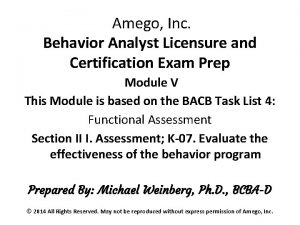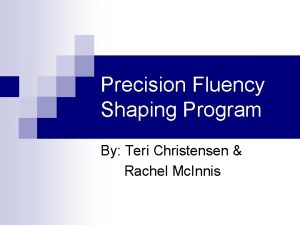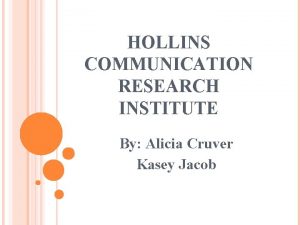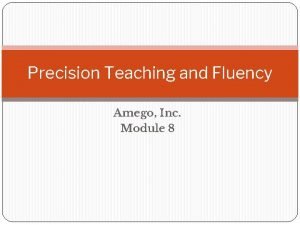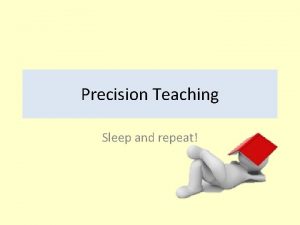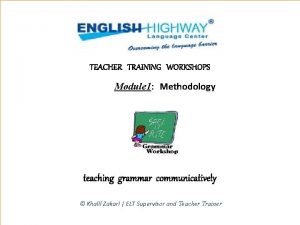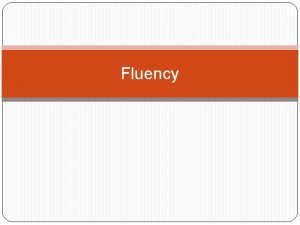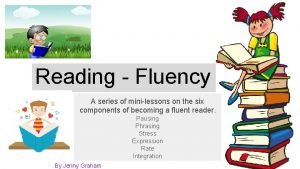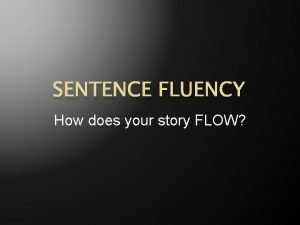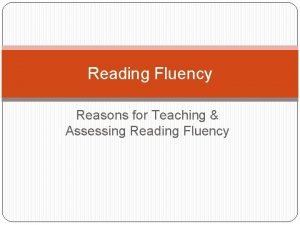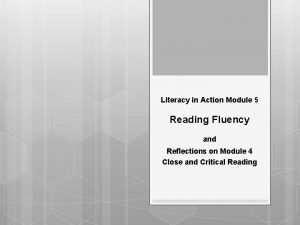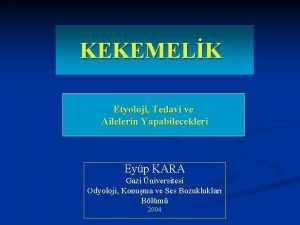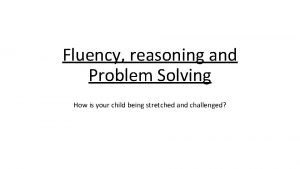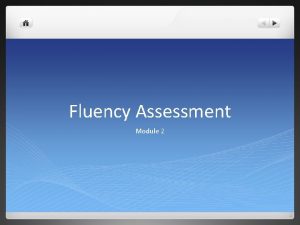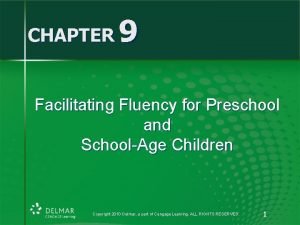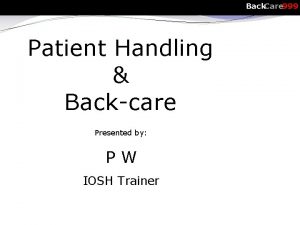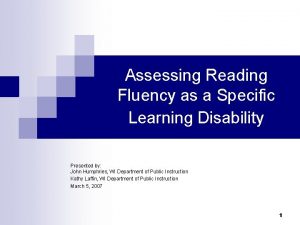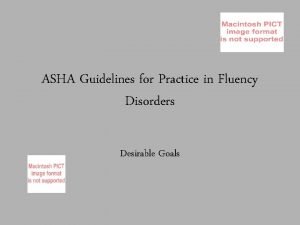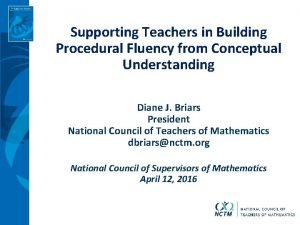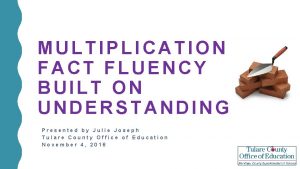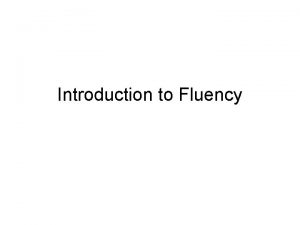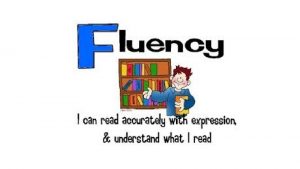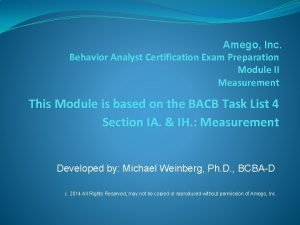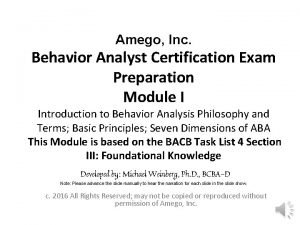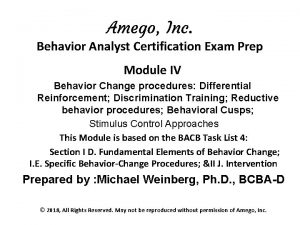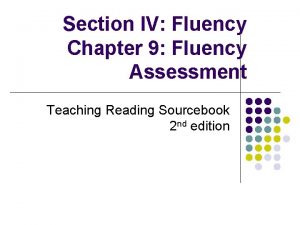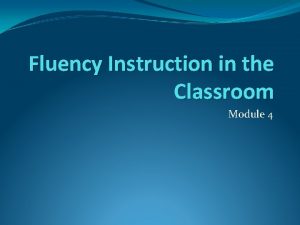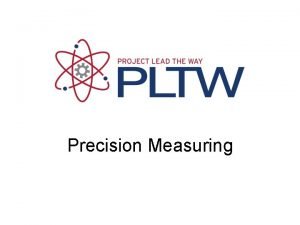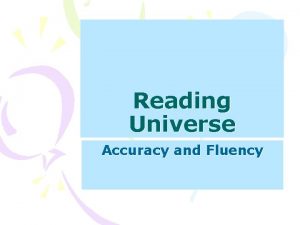Precision Teaching and Fluency Amego Inc Module 8


































- Slides: 34

Precision Teaching and Fluency Amego, Inc. Module 8

A brief history of Precision Teaching � 1965 - began in self-contained special education classrooms of the Children’ Rehabilitation Unit at the University of Kansas Medical center. The first pupil behaviors that were self-monitored were mostly the handicapping conditions selected for rehabilitation (Koening, 1967; Slezak, 1969) � 1970 – mostly through the work of Eric Haughton and his students at the University of Oregon, selfmonitoring of academic products moved into classwide regular elementary classrooms. �Middle 1970 – large scale district and state-wide projects attracted federal government funding and trained large numbers of teachers in Precision teaching. �Precision teaching inherited “rate of response” and “cumulative response recording” from B. F. Skinner. This legacy is unique since Precision teaching is the only instructional system derived from Skinner’s work to use his monitoring method exclusively.

A brief history of Precision Teaching �The method of instruction called Precision Teaching was first formulated by Ogden Lindsley, who left basic behavioral research at Harvard Medical School in 1964 to develop Precision Teaching at the University of Kansas. �Viewing a behavioral repertoire as a sort of nexus, many influences funneled into Lindsley’s scientific repertoire, which later determined the direction taken by precision teaching. �Most behavior analysts probably recognize the influence of Skinner on Lindsley and precision teaching but the influence of these other scientists may have been equally significant.

KEY WORDS � B. F. Skinner � Ogden Lindsley � Fluency � Rate of response � Cumulative records �Standard Celeration Chart �School-wide norms comparisons �Performance Standards

What is Precision Teaching? �Formative assessment in instruction �Developed from Behaviorist methodology (Applied Behavioral Analysis, Verbal Behavior, others) �Complementary to Direct Instruction (DI), which is how many apply PT, but does not need to be exclusively used only when using DI �Works with “constructing behavioral [including academic skill] repertoires” to provide effective instruction and measure skill growth

What is Precision Teaching cont. Precision teaching is adjusting the curricula for each learner to maximize the learning shown on the learner’s personal standard celeration chart. The instruction can be by any method or approach. � For example, the most effective applications of Precision Teaching have been when it is combined with Direct Instruction. The materials are derived from Direct instruction and the curricular change decisions, fluency aims and one-minute practice sessions are from Precision teaching. � The precision comes from making curricula changes based on changes in the weekly learning of each student. The weekly learning changes are seen on standard celeration charts. The frequencies of correct and incorrect responses of each subject are recorded daily on separate standard charts. � Because of the normal daily variation in performance frequency, it takes one to two weeks to project a learning course and to determine a change in learning.

What is Precision Teaching, cont. “The key components of Precision Teaching are: to set time-based mastery criteria for each curriculum step, to provide daily opportunities for practice and timed measurement, to chart performance on a graph called the Standard Behavior [Celeration] Chart and to change procedures when the chart shows they're not working (Pennypacker, Koenig and Lindsley, 1972; White and Haring, 1980). ” (Binder, 1988)

Principles of Precision Teaching There are four foundation principles of PT : 1. The child knows best 2. Focus on observable behaviors 3. Use frequency measures to monitor performance 4. Use a standardized graphical display

What is Precision Teaching, cont. �Curriculum objectives broken into skill steps (component to composite skills) �Skill steps are taught and practiced, peer tutoring/paired learning often occurs �Daily, 10 -20 minutes for skill lesson, practice, skill measurement and charting �Instruction builds in direct engagement in the skill; argues that most general instruction does not engage the learner in the targeted skill for enough direct instruction �Results of charting lead to skill or instructional changes or directions, helps to know when learner is ready to move on �The primary goal of instruction is to build fluency with a skill; fluency implies readiness to expand understanding and comprehension

How Costly is it? Precision Teaching appears to be cost effective. By 1984, Precision teaching was well established in many kindergarten through 12 th grade regular education classrooms. The costs for: � The first training year ranged from $25 to $8000, with a median of $300 per year per teacher � Subsequent years ranged from $5 to $400, with a median of $60 per teacher per year, or only $3. 50 per pupil per year. Albrecht, 1984

The Celeration Chart �Displays behavioral frequencies, celeration changes, and bounce that correspond to the natural flow of behavior �Measures the behavior select time intervals (usually 1 min. , can be few seconds to few minutes) �Does NOT start with a baseline �Child chooses the target behavior; experts say that they will pick the behavior you wanted them to pick by the 3 rd-4 th behavior charted

Celeration Chart Likeness

Precision Teaching “REAPS” Benefits �Retention – meaningful recall of info �Endurance- of quality recall over time �Application - over settings, incorporating simple into complex skills �PS – Performance Standards, or the targeted benchmark set for fluent behavior

What Does the Research Say? “Science is facts; just as houses are made of stones, so is science made of facts; but a pile of stones is not actually a house and a collection of facts is not necessarily science” Henri Poincaré In the scientific discipline of education, Precision teaching offers a measurement system that has no comparison. • The first tool of discovery and analysis flows from precise description of behavior; • Employ a sophisticated and well-constructed method for recording data • Standard Celeration Chart due to it’s ratio scale, standard nature, focus on relative and promotional displays of data, and rates of change is the most important in PT.

As Summarized by Merbitz and colleagues, Chapters 4 & 5, Evidence-Based Educational Methods � Private schools and learning centers raise achievement by 1 grade level in 20 hours of instruction (p. 47) � In Great Falls, after 4 years of PT methods used, HS’s were overwhelmed with students wanting AP classes (p. 49) � PT “is the quintessential form of data-driven decisionmaking” (p. 49), an “astonishingly powerful technology (p. 48) � Has been applied to hand movements (pp. 64 -65) and other behaviors of autism with success (p. 71), took Lovaas’s methods from simple acquisition to fluency of skill

What Does the Research say? As Summarized by Merbitz and colleagues, Chapters 4 & 5, Evidence-Based Educational Methods �Has been successfully used with college/adult learners, TBI, severe disabilities, rehab patients with success (p. 69 -71) �Has been successfully applied to self-charting of thoughts. feelings and urges for self-improvement (p. 74)

What Does the Research Say? cont. • One of the most cited successful application of Precision Teaching was conducted in Great Falls, Montana in the early 1970’s (Beck, cited in Binder& Watkins, 1990). During a four year span, teachers at Scajawea elementary school incorporated 20 to 30 minutes of daily Precision teaching into a curriculum that was otherwise identical to other schools in the district. • Their students advanced 19 -40 percentile points higher on the Iowa Test of Basic Skills than students elsewhere in the district.

Precision Teaching: A Five-Step Process Mc. Greevy (1983) outlined Precision Teaching as a five-step process in his wonderful book, Teaching and Learning in Plain English. What follows is a summary of Mc. Greevy's presentation. • Select a Task (Pinpoint) • Set an Aim • Count and Teach • Develop a Learning Picture • Decide What to Do

1. Select a Task (Pinpoint) A task should be: (A) countable - Precision Teachers attempt to translate learning tasks into concrete, directly observable behaviors that can be counted and recorded (B) have a counting period - The counting period is the amount of time each day one spends counting the movement (Mc. Greevy, 1983) (C) include a correct /incorrect pair - A task description should include both what to do (correct) as well as what not to do (incorrect). (D) specify the learning channel set - Each task description should be make clear both the input (or receive) channel and an output (send) channel. (E) be a movement that is "hard-to-do. ” - The goal is to teach the student a new task, not something he or she already knows how to do.

Step 2: Set an Aim � The aim refers to the final desired level of performance, generally one in which there is a high frequency of correct movements and a zero frequency of incorrect movements. This is referred to as reaching aim and "0". � In recent years, however, many Precision Teachers have abandoned this practice and started using minimum component behavior frequencies to establish aims (Binder, 1996)

Step 3: Count and Teach Here are two general possibilities. � If the output channel involves saying or performing, then the teacher may simply watch the student and count instances of correct and incorrect movements as they occur. � If the output channel involves a task with physical properties that are difficult to quantify, such as the act of writing a correctly spelled word, then the teacher might count some critical outcome of that movement at the end of the assessment period (e. g. , the frequency of correct and incorrect word spellings written on paper by the student).

Step 4: Develop a Learning Picture �The Standard Celeration Chart is inspected for changes in counts per minute over daily assessment periods for both correct and incorrect movements. The two trends form a learning picture. �The picture tells the teacher and student how rapidly the movements are increasing or decreasing and helps them project if or when the student will reach aim.

Step 5: Decide What to Do �Teaching decisions are based on the shape of the learning picture that emerges on the Standard Celeration Chart. � White & Haring (1980) recommend that "If the correct rate of a skill is higher than the error rate and is accelerating (regardless of how the error rate might be changing), the skill is probably appropriate for one or more of the instructional procedures" (p. 243). �Given this learning picture, the decision would be to continue with the current program.

Precision Teaching- It’s All About the Fluency!!! � Fluency NOT = Accuracy; = Acc + Speed � “Whether it be speaking a foreign language, completing basic arithmetic calculations, reciting knowledge of American history, reading a story aloud, playing the guitar, dancing, or using computer software, masterful performance is quick and nearly automatic, rather than slow and hesitant. People can observe this difference in their own behavior and in the behavior of others. Yet conventional percentage correct scores, the standard in our educational system, cannot differentiate between these obviously different levels of achievement “ (Barrett, 1979).

Precision Teaching and Fluency, cont. � A major Precision Teaching finding (Haughton, 1972) is that students must achieve fluency in "tool" skills in order to progress smoothly to more advanced material. � A common reason for failure in basic math skills, for example, is that students have not been allowed to achieve fluency in basic number-writing and digit-reading, despite being able to perform these skills accurately. � When they do not achieve sufficient levels of basic arithmetic computation (e. g. , 50 to 70 problems per minute), students usually experience difficulty learning long division, algebra and other advanced math skills. � Thus, many so-called "learning disabilities" turn out to be no more than a failure of the schools to measure and to work toward fluency in basic skills.

Precision Teaching and Fluency, cont. Referenced Fluency Benchmarks (Research cited by Kubina & Morrison, 2000) �Seeing/saying words in context or in oral reading at 180 -200 Words Per Minute (Kubina & Starlin: 150 -250 WPM) �Seeing/writing math facts at 70 -90 Digits Per Minute �Thinking/writing alphabetic letters at 150 Words Per Minute

Precision Teaching and Fluency, cont. �Pick a skill, i. e. Math +/- facts, older students Give a 1 minute assessment, e. g. , 75 problems of: 3 6 4 5 5 -5 + 2 +3 -8 +2 etc. Or +/- series problems like start: 4 add: 4 = 4 ___ 16 ___ 28 ___ start: 4 add: 4 = 4 ___ 12 ___ 20 ___ 28 ___ start: 8 add: 8 = 8 ___ 32 ___ 56 ___

Precision Teaching and Fluency, cont. Other “Pick a Skill” examples: �WPM �Reciting vocabulary words for a given definition �Discriminating whether terms or concepts came from the Declaration of Independence or the Constitution �Naming colors/letters/shapes/sizes

How Do You Measure Fluency? �Oral reading probes �Math computation probes �Flashcards known as SAFMEDS (Say All Fast a Minute Each Day Shuffled) �Student or Teacher Tally of Observed Behavior

Precision teaching is a precise and systematic method of evaluating instructional tactics and curricula. It is one of the few quantitative analyses of behavior forms of applied behavior analysis.

References http: //www. celeration. org/references. htm An exhaustive bibliography on PT http: //www. autismteachingtools. com/page/bbbbfg/bbbbfz PT applied with autistic populations http: //www. celeration. org/index. htm Home page of The Standard Celeration Society http: //www. fluencyfactory. com/Precision. Teaching. Links. html One stop shop for PT http: //members. aol. com/standardcharter/define. html The How To’s of Celeration Charts

References http: //fluency. org/ – links to PT tutorial and advanced narratives and research papers http: //psych. athabascau. ca/html/387/Open. Modules/Lindsley/ Athabascau University – good tutorial on PT http: //courses. washington. edu/edspe 510/510_Syllabus. htm Renowned PT expert and his Univ. of Washington course syllabus – people are learning PT principles!

References � Binder, C. (1996). Behavioral fluency: Evolution of a new paradigm. The Behavior Analyst, 19, 163 -197. � Beck, R. , & Clement, R. (1991). The Great Falls Precision Teaching Project: A historical examination. Journal of Precision Teaching, 8(2), 8 -12. [a. k. a. “Sacajawea Project”] � Binder, C. (1988). Precision teaching: Measuring and attaining exemplary academic achievement. Youth Policy Journal, 10(7), 12 -15. � Graf, S. , & Lindsley, O. (2002). Standard Celeration Charting 2002. Youngstown, OH; Graf Implements. � Kubina, R. M. , & Morrison, R. S. (2000). Fluency in education. Behavior and Social Issues, 10, 83 -99.

References � Binder, C. , & Watkins, C. L. (1990). Precision teaching and direct instruction: Measurably superior instructional technology in schools. Performance Improvement Quarterly, 3(4), 74 -96. . � Lindsley, O. R. (1990 a). Our aims, discoveries, failures, and problem. Journal of Precision Teaching, 7, 7 -17. � Lindsley, O. R. (1990 b). Precision teaching: By teachers for children. Teaching Exceptional Children, 22(3) � Mc. Greevy, P. (1983). Teaching and learning in plain English. Kansas City, MO: Plain English Publications (University of Missouri). � Skinner, B. F. (1938). The behavior of organisms. Englewood Cliffs, NJ: Prentice-Hall. Note: This Module corresponds to Amego, Inc. Task List 4 Probe #10
 Amego inc
Amego inc Precision fluency shaping program review
Precision fluency shaping program review Precision fluency shaping program review
Precision fluency shaping program review Linear measurement tools
Linear measurement tools Semiprecision attachment
Semiprecision attachment Bcd gösterimi
Bcd gösterimi Precision x-ray, inc.
Precision x-ray, inc. Precision teaching definition
Precision teaching definition Precision teaching grid
Precision teaching grid Teaching and assessment of grammar module 1
Teaching and assessment of grammar module 1 Definitions of micro teaching
Definitions of micro teaching C device module module 1
C device module module 1 In the poem watch me grow to what is reading compared
In the poem watch me grow to what is reading compared Accuracy and fluency
Accuracy and fluency Six dimensions of fluency
Six dimensions of fluency Stages of learning acquisition maintenance generalization
Stages of learning acquisition maintenance generalization Speech emergence stage activities
Speech emergence stage activities Sentence fluency is
Sentence fluency is Woodcock johnson test of achievement iv
Woodcock johnson test of achievement iv Reading accuracy
Reading accuracy Reading wpm chart
Reading wpm chart Van riper tekniği pdf
Van riper tekniği pdf Intercultural fluency
Intercultural fluency Functional fluency
Functional fluency Fluency with information technology
Fluency with information technology Fluency reasoning problem solving
Fluency reasoning problem solving Fluency is the ability to
Fluency is the ability to Fluency friday
Fluency friday Cbm reading fluency passages
Cbm reading fluency passages Preschool fluency activities
Preschool fluency activities Manual handling mnemonic fluency
Manual handling mnemonic fluency Definition of reading fluency
Definition of reading fluency Fluency goals asha
Fluency goals asha Explain the basis of procedures
Explain the basis of procedures Multiplication fact
Multiplication fact
